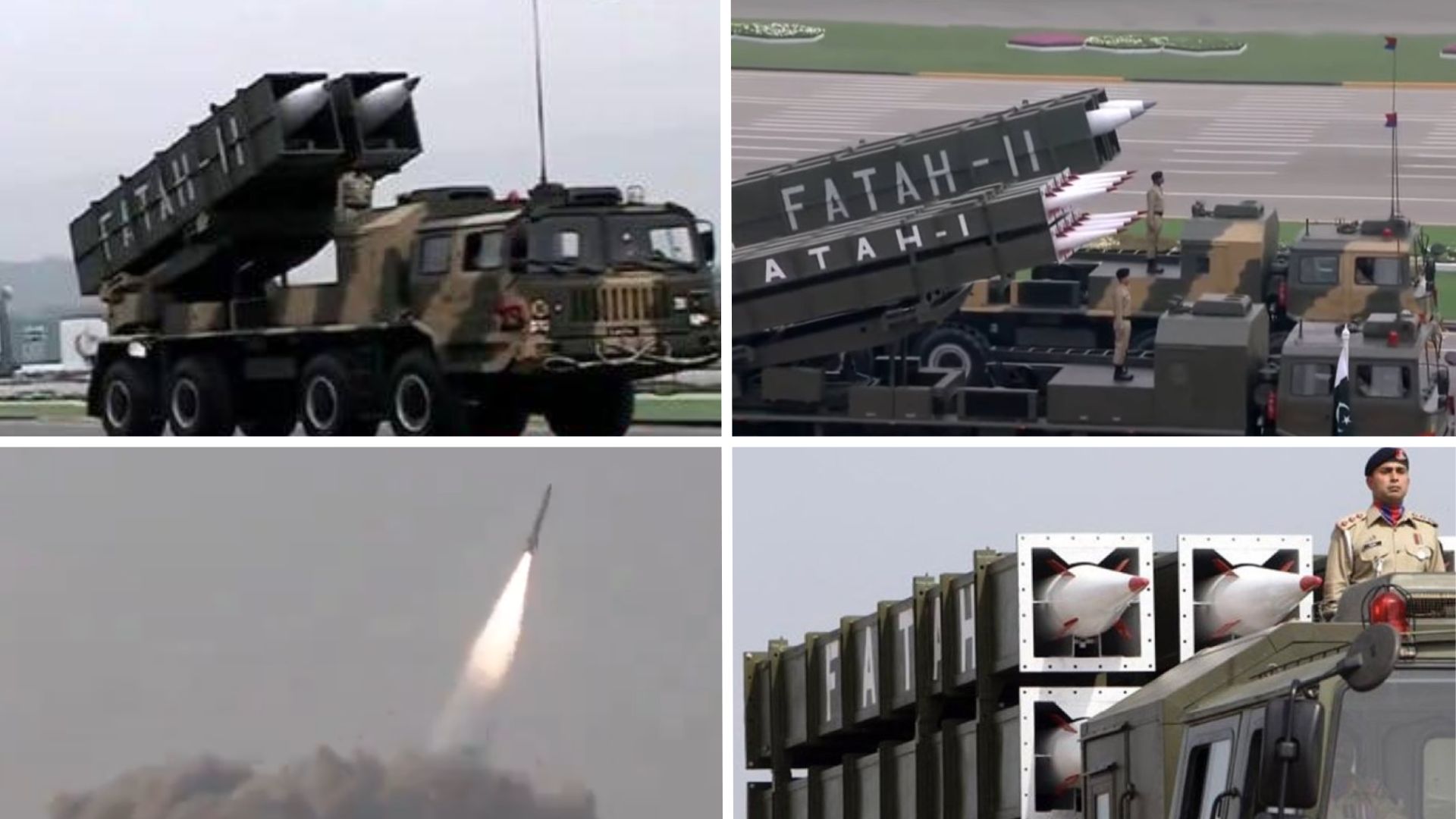(VIDEO) Fatah Strikes: Pakistan’s Game-Changing Precision Rockets Shake India’s Strategic Depth
Witnessing the Pakistani military launch guided rockets from Fatah-series systems toward Indian territory is a stark visual of how the Indo-Pak conflict may no longer be confined to border skirmishes, but has now entered the realm of long-range, standoff strike warfare.
(DEFENCE SECURITY ASIA) – In the waning hours before a tentative ceasefire was enacted, bringing a fragile pause to open hostilities between nuclear-armed neighbours Pakistan and India, Islamabad deployed some of its most advanced and disruptive battlefield systems—capabilities that have sent shockwaves through Indian military command circles.
At the centre of this battlefield escalation were the Fatah-1 and Fatah-II Guided Multiple Launch Rocket Systems (GMLRS), domestically engineered by Pakistan’s National Engineering and Scientific Commission (NESCOM) and globally marketed by the state-owned defence giant Global Industrial & Defence Solutions (GIDS).
These systems represent Pakistan’s strategic leap into high-precision, long-range strike capability—akin to the U.S.-made M142 HIMARS—but tailored for the South Asian theatre, designed for both tactical interdiction and deep strategic disruption of adversary rear infrastructure.
Built for deterrence and offensive parity in a region marked by recurring crises, the Fatah-series is widely seen as a counterbalance to India’s expanding inventory of cruise missiles, surface-to-surface weapons, and layered air defences.
The activation of Fatah-1 and Fatah-II in live conflict scenarios marks a critical threshold in South Asia’s evolving precision-guided munitions (PGM) race, a phase in which conventional artillery transitions from massed fires to surgical, high-lethality engagements.
Witnessing the Pakistani military launch guided rockets from Fatah-series systems toward Indian territory is a stark visual of how the Indo-Pak conflict may no longer be confined to border skirmishes, but has now entered the realm of long-range, standoff strike warfare.
Reports indicate that Fatah-II, in particular, was designed in direct response to India’s Cold Start Doctrine (CSD)—a limited war strategy formulated to enable rapid conventional incursions into Pakistani territory before international pressure can intervene.
Video Player
00:00
00:00
Pakistan’s military planners believe Fatah-II disrupts this doctrine by holding key Indian command, control, and logistical nodes at risk deep behind the frontlines, thereby neutralising India’s ability to mobilise swiftly without consequence.
For the first time in the history of subcontinental conflict, Indian rear-echelon military installations, including air bases, ammunition depots, and logistics hubs, have come under direct threat from Pakistan’s conventional artillery platforms.
Following Indian cruise missile strikes using BrahMos and SCALP EG munitions on six critical Pakistani airbases—including Noor Khan, Mureed, and Shorkot—Islamabad reportedly retaliated with precision rocket salvos using both Fatah-I and Fatah-II systems.
Some sources claim that at least one Fatah-II rocket, capable of striking targets up to 400 km away, was launched against a military facility in New Delhi, though Indian information suppression has made independent damage assessment impossible.
Both Fatah-1 and Fatah-II are fitted with advanced inertial and satellite-based navigation systems (INS/GPS), enabling them to strike within meters of high-value targets, including enemy radar sites, command posts, and hardened shelters.
“These systems, from Fatah-I to the forthcoming Fatah-II, are tailored for both tactical and strategic applications alike, enabling deep penetration strikes into enemy territory,” said a regional defence analyst.
Video Player
00:00
00:00
The fielding of these systems is part of Pakistan’s broader push for self-reliance in defence technology, with GIDS playing a pivotal role in translating research into field-ready weapon platforms.
Both rocket systems are integral to a wider modernisation plan aimed at transforming Pakistan’s legacy artillery forces—traditionally reliant on unguided systems—into a precision-strike force capable of operating within a network-centric warfare environment.
The transition from legacy systems like the Yarmouk-series to the precision-guided Fatah-series also reflects a doctrinal pivot toward standoff strike warfare, enabling Pakistan to disrupt key enemy assets from outside the engagement range of conventional air defence systems like Barak-8 and Akash.
Defence analysts believe the Fatah-series marks a generational leap in Pakistan Army artillery capabilities, allowing it to deter high-value incursions and retaliate with conventional force projection at operational depths that were previously unreachable.
“The Fatah system reflects Pakistan’s doctrinal pivot from merely matching conventional force with force to embracing precision-strike capabilities that can impose strategic costs on enemy command and logistics structures,” said a senior defence researcher.
He emphasised that long-range precision strike not only enhances battlefield survivability but also imposes psychological pressure by threatening critical infrastructure beyond the forward edge of battle.

Another expert noted that “transitioning from unguided artillery to precision GMLRS sends a strategic message—the next war will not be about mass fires but about hitting decisively and disrupting early.”
The increasing range and accuracy of Fatah-II, in particular, may render India’s static air defence networks obsolete or require significant reallocation of resources to protect inland bases previously considered safe.
Fatah-1 and Fatah-II: Precision Strike Force Multipliers Reshaping South Asia’s Artillery Battlefield
Pakistan’s investment in the Fatah-series reflects a deliberate shift toward high-end battlefield effects—enabling precision fires at extended ranges without escalating to ballistic missile warfare.
These weapons are not simply deterrents but tools of active combat, redefining the conventional balance between Islamabad and New Delhi by introducing high-precision standoff artillery as an operational staple in future conflicts.

Technological Overview: Fatah-1 vs Fatah-II
Specification |
Fatah-1 |
Fatah-II |
|---|---|---|
Type |
Guided Multiple Launch Rocket System |
Guided Multiple Launch Rocket System |
Range |
Up to 140 km |
Estimated up to 400 km |
Guidance |
Inertial Navigation System (INS) + GPS |
Inertial Navigation System (INS) + GPS |
Accuracy (CEP) |
<10 metres |
<10 metres |
Warhead Type |
High-Explosive (HE) Conventional |
High-Explosive (HE) Conventional |
Launcher |
8×8 Tactical Wheeled Vehicle |
8×8 Tactical Wheeled Vehicle |
Launcher Config. |
Modular – Multiple Rocket Tubes |
Modular – Multiple Rocket Tubes |
Standoff Capability |
Yes – Fires from outside air defence range |
Yes – Extended range & mobile deployment |
Operational Status |
In service with Pakistan Army |
Operational as of 2023 |
Initial Reveal |
2021 (Field-tested & validated) |
2023 (Revealed by GIDS) |
Key Takeaways
-
Fatah-1 and Fatah-II are core components of Pakistan’s “smart artillery” evolution, aiming to dominate the battlespace without resorting to strategic missile escalation.
-
Unlike saturation fire from unguided systems, Fatah offers selective, high-precision targeting of time-sensitive or hardened assets.
-
Their “shoot-and-scoot” design significantly increases survivability against counter-battery radar and drone surveillance.
Strategic Implications for South Asia
With the Fatah-series, Pakistan has fundamentally altered the geometry of its conventional deterrence—creating overlapping zones of influence across critical Indian military infrastructure without violating thresholds that could trigger nuclear retaliation.
The integration of GMLRS into Pakistan’s doctrinal core also signals a future in which conventional, precision warfare could dominate Indo-Pak conflict scenarios—reshaping how both sides plan and execute preemptive or retaliatory strikes.
In the face of India’s increasingly layered missile shield, the Fatah-series delivers a cost-effective, high-impact solution that complicates New Delhi’s strategic calculus and forces a rebalancing of air defence resources deep into the Indian heartland.
— DEFENCE SECURITY ASIA



In recent wars between lndia and Pak, the Pak Airforce has always been at the top. Pak pilots are better trained.
All the Pakistani propaganda supported by favourable and paid media channels have been punctured and exposed with evidence at the world stage. So all the holes are visible now to the world. In reality Pak was utterly and totally helpless after Day2 of the war.